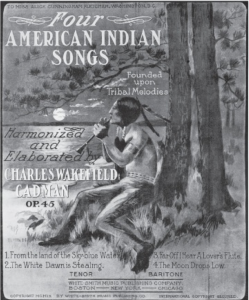In Charles Wakefield Cadman’s 1909 work, “Four American Indian Songs,” he attempts to create a “purely American” music by setting original Native American melodies, as transcribed by Alice Fletcher, in a traditional Western harmonic idiom. This musical effort, sometimes described as “Indianism,” may appear at first to be a laudable one. By adding English words and Western harmonies, Cadman ensures that these Native American melodies will be heard by a wide variety of people. If he could bring these Native American folk melodies into the mainstream of American song, they could be preserved and celebrated for years to come.
Surely enough, Cadman purports to have a certain amount of respect for Native American culture, and his methods do strive for a sort of “authenticity.” In his article “The ‘Idealization’ of Indian Music,” Cadman cites the importance of understanding the Native cultures that he borrows from. He recommends that an Indianist composer should learn about Native American legends and rituals, attend powwows, and even spend time living on a Reservation if possible, before attempting “idealize” (read: Westernize) Native music.
Despite his lofty aspirations of sympathy and understanding, however, Cadman ultimately falls short of the mark. Throughout his article, he consistently describes Native American people as “primitive,” and makes the claim that “only one-fifth of all Indian thematic material is valuable in the hands of a composer.” Cadman does not view Native American musical traditions as inherently valuable and worthy of study, but rather as a quarry of raw materials that he can mine for his own profit. His musical project, which initially appeared to be a beautiful marriage of two disparate traditions, instead smacks of exploitation and imperialism. . . is it possible, then, that perhaps he has succeeded in writing “purely American” music after all?
Sources
Blim, Dan. “MacDowell’s Vanishing Indians.” AMS 2016, Vancouver.
Cadman, Charles Wakefield. “Idealization of Indian Music.” Musical Quarterly, vol. 1, July 1915, pp. 387-396. EBSCOhost, accessed 24 Sept. 2017.
Cadman, et al. Four American Indian Songs : Op. 45, for Voice and Piano. Boca Raton, Fla., Masters Music Publications, 1989.
Garrett, Charles Hiroshi. The Grove Dictionary of American music. Second ed., vol. 2, New York, Oxford University Press, 2013.
Levy, Beth E. Frontier Figures: American Music and the Mythology of the American West. University of California Press, 2012. ProQuest Ebook Central, accessed 24 Sept. 2017.


This is a great post, not just because your writing is engaging (the last sentence – what a zinger!) but also because you manage to connect course content with an unfamiliar piece of music (had *you* heard of Cadman before doing this research?) with a legitimately interesting primary source. I’m grateful for your sources list, which shows that you were thinking about the readings we did in class while writing this; the next step is to do a bit of “name dropping” in your prose and show exactly where you’re drawing on specific writers (for instance, naming Blim when you mention “Indianism”). Add a few tags, offer a few more hyperlinks in case readers want to go down a rabbit hole of your design on any of the keywords in your post, and you’ll be in great shape. Keep up the good work!